
Berchtesgaden is a municipality in the district Berchtesgadener Land, Bavaria, in southeastern Germany, near the border with Austria, 30 km (19 mi) south of Salzburg and 180 km (110 mi) southeast of Munich. It lies in the Berchtesgaden Alps. South of the town, the Berchtesgaden National Park stretches along three parallel valleys.
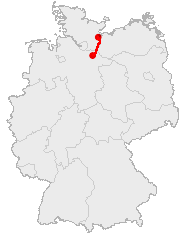
The Old Salt Route was a medieval trade route in Northern Germany, one of the ancient network of salt roads which were used primarily for the transport of salt and other staples. In Germany it was referred to as Alte Salzstraße.

Lüneburg, officially the Hanseatic City of Lüneburg and also known in English as Lunenburg, is a town in the German state of Lower Saxony. It is located about 50 km (31 mi) southeast of another Hanseatic city, Hamburg, and belongs to that city's wider metropolitan region. The capital of the district which bears its name, it is home to roughly 77,000 people. Lüneburg's urban area, which includes the surrounding communities of Adendorf, Bardowick, Barendorf and Reppenstedt, has a population of around 103,000. Lüneburg has been allowed to use the title "Hansestadt" in its name since 2007, in recognition of its membership in the former Hanseatic League. Lüneburg is also home to Leuphana University.

Park City is a city in Utah, United States. The vast majority is in Summit County, and it extends into Wasatch County. It is considered to be part of the Wasatch Back. The city is 32 miles (51 km) southeast of downtown Salt Lake City and 20 miles (32 km) from Salt Lake City's east edge of Sugar House along Interstate 80. The population was 8,396 at the 2020 census. On average, the tourist population greatly exceeds the number of permanent residents.

The Kehlsteinhaus is a Nazi-constructed building erected atop the summit of the Kehlstein, a rocky outcrop that rises above Obersalzberg near the southeast German town of Berchtesgaden. It was used exclusively by members of the Nazi Party for government and social meetings. It was visited on 14 documented instances by Adolf Hitler. Today, it is open seasonally as a restaurant, beer garden, and tourist site.

Hallstatt is a small town in the district of Gmunden, in the Austrian state of Upper Austria. Situated between the southwestern shore of Hallstätter See and the steep slopes of the Dachstein massif, the town lies in the Salzkammergut region, on the national road linking Salzburg and Graz.
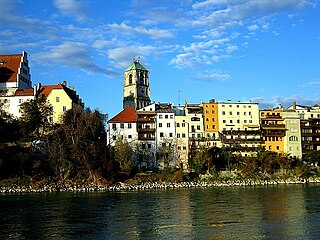
Wasserburg am Inn is a town in Rosenheim district in Upper Bavaria, Germany. The historic centre is a peninsula formed by the meandering river Inn. Many Medieval structures remain intact, giving the city a unique view.
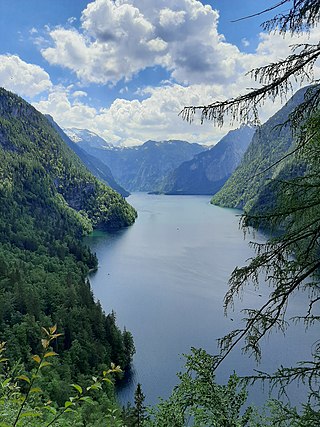
The Königssee is a natural lake in the southeast Berchtesgadener Land district of the German state of Bavaria, near the Austrian border. Most of the lake is within the Berchtesgaden National Park.

Zipaquirá is a municipality and city of Colombia in the department of Cundinamarca. Its neighboring municipalities are Cogua and Nemocón to the north; Tocancipá to the east; Tabio, Cajicá and Sopó to the south; and Subachoque and Pacho to the west. Its seat of municipal government is 49 kilometers from the national capital Bogotá. It is part of the Greater Bogotá Metropolitan Area, and is the capital of the Sabana Centro province. It is also the headquarters of the diocese of the same name and that includes much of the Department of Cundinamarca, extending to the centre of Bogotá, the region of Rionegro, the Ubaté Valley, and the region of Guavio.

Obersalzberg is a mountainside retreat situated above the market town of Berchtesgaden in Bavaria, Germany. Located about 120 kilometres (75 mi) south-east of Munich, close to the border with Austria, it is best known as the site of Adolf Hitler's former mountain residence, the Berghof, and of the mountaintop Kehlsteinhaus, popularly known in the English-speaking world as the "Eagle's Nest". All of the Nazi era buildings were demolished in the 1950s, but the relevant past of the area is the subject of the Dokumentationszentrum Obersalzberg museum, which opened in 1999.

The Khewra Salt Mine, also known as Mayo Salt Mine, is the world's second largest salt mine, located in Khewra, Punjab, Pakistan. The mine is in the Salt Range of the Potohar plateau, which rises from the Indus plain of the Punjab.

Bad Friedrichshall is a town in the district of Heilbronn in Baden-Württemberg in southern Germany. It is situated at the confluences of the Jagst and of the Kocher into the Neckar, some 10 kilometres (6 mi) north of Heilbronn. Bad Friedrichshall arose by the connection of Kochendorf and Jagstfeld in 1933, and is famous for its salt mine.

The Wieliczka Salt Mine is a salt mine in the town of Wieliczka, near Kraków in southern Poland.
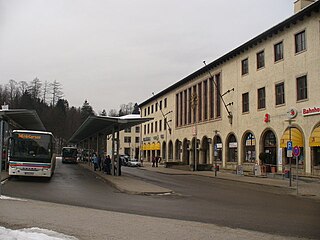
Berchtesgaden Hauptbahnhof is a railway station in the Bavarian market town of Berchtesgaden, the smallest town in Germany with a Hauptbahnhof. It has five platform tracks and is classified by Deutsche Bahn as a category 5 station. It is the terminus of the Freilassing–Berchtesgaden railway. Previously the Berchtesgaden–Hangender Stein railway, also called the Grüne Elektrische started from the station. Within walking distance of the station (Triftplatz) was the former station of Königssee Railway, which served the lake of Königssee. The station is served by about 20 trains daily operated by Deutsche Bahn and the Berchtesgadener Land Bahn.

Schönau am Königssee is a municipality in the district of Berchtesgadener Land in the German state of Bavaria. It is located at the northern end of the Königssee lake.
Adolf Hitler personally owned an extensive collection of books. Nazi politician Baldur von Schirach claimed that Hitler had about 6,000 volumes and that he had read each one. Tyler James Oechsner estimated the collection at 16,300 volumes. No records exist to confirm the amount, as several books were destroyed by the Allies.

The Bochnia Salt Mine in Bochnia, Poland, is one of the oldest salt mines in the world and is the oldest commercial company in Poland. The Bochnia salt mine was established in 1248 after salt had been discovered there in the 12th and 13th centuries, and became part of the royal mining company, Żupy krakowskie. In 1990, the mine ceased producing salt but remains a tourist attraction.

The Technical Hallors and Saline Museum was founded in the buildings of the former Royal Prussian Saline, Halle upon Saale in 1967. Hallors had been members of a brotherhood of salt producers.
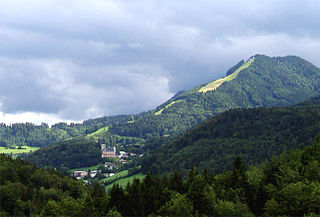
Dürrnberg, also named Bad Dürrnberg, is an Austrian village part of the municipality of Hallein, in Hallein District (Tennengau), Salzburg State. It is the location of the Hallein Salt Mine.

The Freilassing–Berchtesgaden railway is an electrified line listed in the Deutsche Bahn timetable as route 954. The 33.671 km long route branches in Freilassing as a single-track line from the double-track Rosenheim–Salzburg railway. It is classified as a line as far as Bad Reichenhall and from there as branch line. The section between Bad Reichenhall-Kirchberg and Hallthurm is considered a steep section with specific operational requirements under Deutsche Bahn's regulations.



















